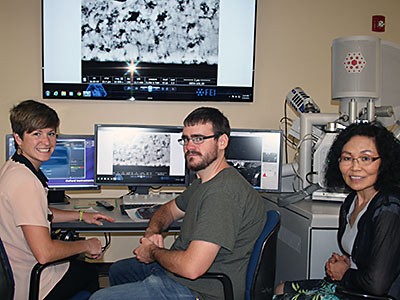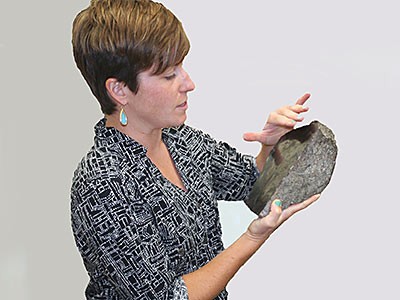Technology Unlocks Ancient Past: USU Geologists Explore Wasatch Fault
From left, USU geologist Alexis Ault; her student, Rob McDermott, a Presidential Doctoral Research Fellow and USU Microscopy Core Facility manager FenAnn Shen use the facility's scanning electron microscope to examine a hematite fault sample.
Utah State University geologist Alexis Ault calls a research facility at the school’s Logan campus “transformative” and says access to the facility’s state-of-art equipment was pivotal in getting recent research findings published.
“My research focuses on documenting when rocks formed in the past and when they cooled to a certain temperature in efforts to understand a variety of Earth processes,” says Ault, assistant professor in USU’s Department of Geology. “Our newly published work about Utah’s Wasatch Fault reveals an intriguing connection between fault damage zone seismicity and its preserved lithologic and geochronologic record.”
The findings, authored by Ault and USU professor Jim Evans, along with colleagues Peter Reiners and Stuart Thomson at the University of Arizona, appear in the July 17, 2015, early online edition of Geology, ahead of a future print edition in the Geological Society of America publication.
The scanning electron microscope or “SEM” in USU’s Microscopy Core Facility, Ault says, is a fundamental tool in deciphering information about hematite, a reddish-black iron ore commonly found in fault zones, including the Wasatch Front.
“If we’re to understand anything about this mineral and the fault, we need to link fault textures at the nano and micro scale with new dating tools,” she says. “The SEM is a tremendous resource for us and my students and I are very fortunate to have this equipment readily accessible right on campus.”
Evans has been trying to pin down the history of fault slip and temperatures along the Wasatch Fault for years and provided Ault with a fascinating hematite fault sample collected from a research site near Willard, Utah.
“I’ll never forget when Jim handed me this sample — it took my breath away,” she says.
The rock has a sheared, mirror-like surface that appears as though it was polished by human tools.
“But it wasn’t,” Ault says. “It’s naturally polished — possibly formed by heat and wear associated with many small earthquakes — to a smooth, glossy finish. We wanted to test that.”
The researchers used a technique called Uranium-Thorium-Helium or “(U-Th)/He” dating on the sample to document past shear heating events related to small earthquakes on the fault surface. Next, they used the SEM to examine the sample’s crystallized surface textures at micro and nano scales.
“Heat imparts a signature — much like a fingerprint — on the rock’s surface,” Ault says. “The hematite had been heated up, then quenched to create polygonal crystals. I was stunned. It reminded me of what I’d seen in quartz and it gave us additional evidence of the heat generated by earthquakes and recorded by the (U-Th)/He data.”
The research is helping the geologists develop a new approach to determine what’s happened to the Wasatch Front over the past million and even two million years.
“The technique we’re creating to study the geologic record is helping us reconstruct the Wasatch Fault history,” she says. “It helps us to better understand the modern earthquake cycle.”
The past is the key to the present, Ault says. “Hematite is everywhere. We’re working to interpret the stories this mineral is trying to tell us.”
Related links:
- “Hot Faults: Iridescent Slip Surfaces with Metallic Luster Document High-Temperature Ancient Seismicity in the Wasatch Fault Zone, Utah, USA,” Geology
- USU Department of Geology
- USU College of Science
Contact: Alexis Ault, 757-784-6452, alexis.ault@usu.edu
Writer: Mary-Ann Muffoletto, 435-797-3517, maryann.muffoletto@usu.edu
USU geologist Alexis Ault displays the mirror-like surface of a hematite fault sample collected near Willard, Utah, by her colleague, Professor Jim Evans. The researchers are working to reconstruct the Wasatch Fault history.
TOPICS
Geosciences 74storiesComments and questions regarding this article may be directed to the contact person listed on this page.








